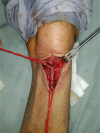Idiopathic true aneurysm of distal radial artery: case report
- PMID: 30349280
- PMCID: PMC6188114
- DOI: 10.2147/VHRM.S182788
Idiopathic true aneurysm of distal radial artery: case report
Abstract
Introduction: The incidence rate of true non-traumatic radial artery aneurysms (RAAs) is low, and very few cases have been described. The majority are traumatic in origin and are iatrogenic pseudo-aneurysms following arterial cannulation. However, other rare causes such as vascular tumors, connective tissue diseases, and occupational injury have also been reported. Only eight cases were reported as idiopathic true RAA. Herein, I describe a case of true idiopathic distal RAA, which was managed by surgical repair.
Case presentation: A 61-year-old-man with no significant medical history presented to vascular clinic with complaint of a nontraumatic mass on the volar aspect and radial side of his right wrist for 6 years. Duplex ultrasound and computed tomography angiogram revealed distal RAA. It was managed by open surgical resection with primary end-to-end anastomosis. Histopathological studies revealed true aneurysm of the distal radial artery.
Conclusion: True distal RAAs are an extremely rare entity. Unawareness of this condition might lead to inappropriate management with significant morbidity. Surgical management is generally indicated, but the best treatment remains controversial.
Keywords: arterial repair; idiopathic; radial artery; true aneurysm.
Conflict of interest statement
Disclosure The author reports no conflicts of interest in this work.
Figures




References
-
- Meira LE, Gouvêa TM, Macedo Tjde. Idiopathic radial artery aneurysm: case report. J Vasc Bras. 2011;10(4):315–318.
-
- Nassiri N, Kogan S, Truong H, Nagarsheth KJ, Shafritz R, Rahimi S. Surgical Repair of a Snuffbox Radial Artery Pseudoaneurysm. Clin Surg. 2016;1:1154.
-
- Walton NP, Choudhary F. Idiopathic radial artery aneurysm in the anatomical snuff box. Acta Orthop Belg. 2002;68(3):292–294. - PubMed
Publication types
MeSH terms
LinkOut - more resources
Full Text Sources
Medical

